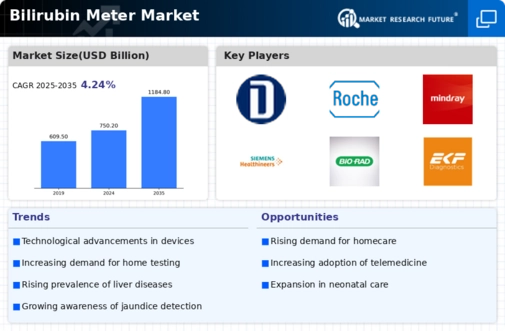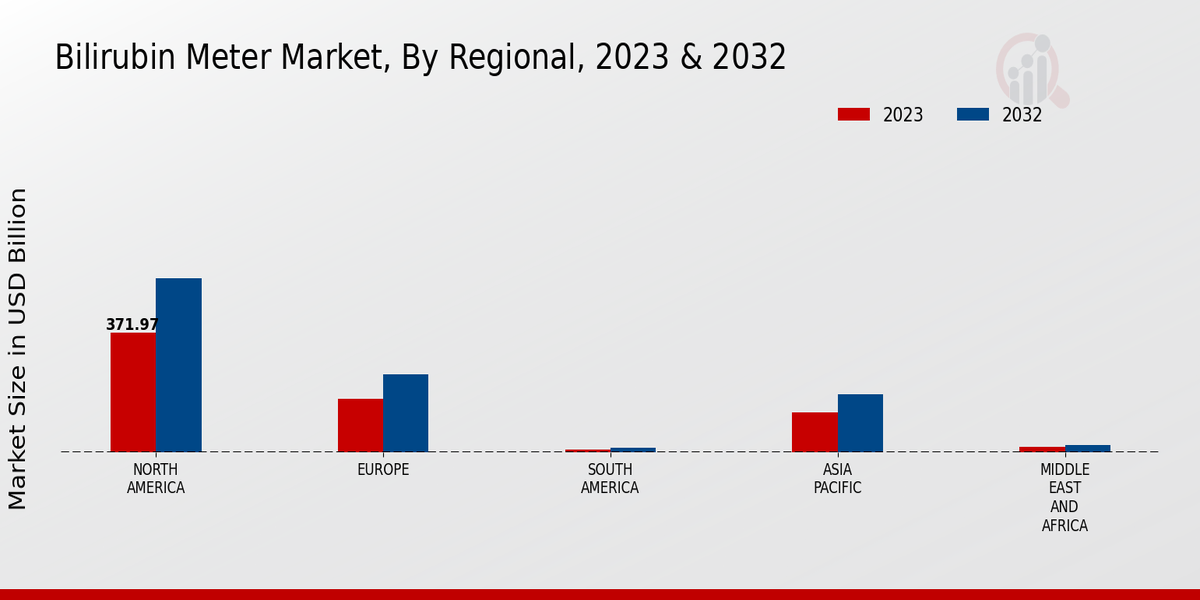Market Growth Projections
The Global Bilirubin Meter Market Industry is poised for substantial growth, with projections indicating a market value of 750.2 USD Billion in 2024 and an anticipated increase to 1184.8 USD Billion by 2035. This growth trajectory suggests a compound annual growth rate of 4.24% from 2025 to 2035. Factors contributing to this expansion include rising healthcare demands, technological advancements, and increased awareness of liver health. As the industry evolves, it is likely to witness the emergence of innovative products that cater to diverse healthcare needs, further driving market dynamics.
Increased Healthcare Expenditure
The rise in global healthcare expenditure is another significant driver for the Global Bilirubin Meter Market Industry. Governments and private sectors are investing more in healthcare infrastructure, which includes diagnostic tools like bilirubin meters. This increased funding allows for the procurement of advanced medical devices, enhancing the quality of care provided to patients. For instance, countries with robust healthcare systems are prioritizing the acquisition of bilirubin meters to improve diagnostic accuracy and patient management. This trend is anticipated to bolster the market, contributing to its growth trajectory as it approaches a valuation of 750.2 USD Billion in 2024.
Rising Incidence of Liver Disorders
The increasing prevalence of liver disorders globally drives the demand for bilirubin meters. Conditions such as hepatitis and cirrhosis are becoming more common, necessitating effective monitoring tools. The Global Bilirubin Meter Market Industry is responding to this need by developing advanced devices that provide accurate and timely results. For instance, the World Health Organization reports that liver diseases account for a significant portion of global mortality, emphasizing the importance of early detection and management. As the market expands, it is projected to reach 750.2 USD Billion in 2024, reflecting the urgent need for reliable diagnostic tools.
Growing Awareness of Neonatal Jaundice
The rising awareness regarding neonatal jaundice is a crucial driver for the Global Bilirubin Meter Market Industry. Parents and healthcare professionals are increasingly recognizing the importance of early detection and treatment of jaundice in newborns. This heightened awareness leads to a greater demand for bilirubin meters, particularly in pediatric care settings. Hospitals and clinics are investing in advanced bilirubin monitoring devices to ensure timely interventions. As a result, the market is expected to grow steadily, with a projected compound annual growth rate of 4.24% from 2025 to 2035, reflecting the ongoing commitment to improving neonatal health outcomes.
Regulatory Support for Diagnostic Innovations
Regulatory bodies worldwide are increasingly supporting innovations in diagnostic technologies, which positively impacts the Global Bilirubin Meter Market Industry. Streamlined approval processes for new devices encourage manufacturers to invest in research and development. This regulatory environment fosters the introduction of cutting-edge bilirubin meters that meet stringent safety and efficacy standards. For example, the U.S. Food and Drug Administration has expedited the review of several novel bilirubin monitoring devices, facilitating their entry into the market. As a result, the industry is poised for growth, with projections indicating a market value of 1184.8 USD Billion by 2035.
Technological Advancements in Diagnostic Devices
Technological innovations in diagnostic devices significantly enhance the capabilities of bilirubin meters. The Global Bilirubin Meter Market Industry is witnessing the integration of features such as non-invasive testing and real-time monitoring, which improve patient outcomes. These advancements not only increase the accuracy of bilirubin measurements but also streamline the workflow in clinical settings. For example, the introduction of portable bilirubin meters allows for point-of-care testing, making it easier for healthcare providers to monitor patients. This trend is likely to contribute to the market's growth, with projections indicating a value of 1184.8 USD Billion by 2035.









